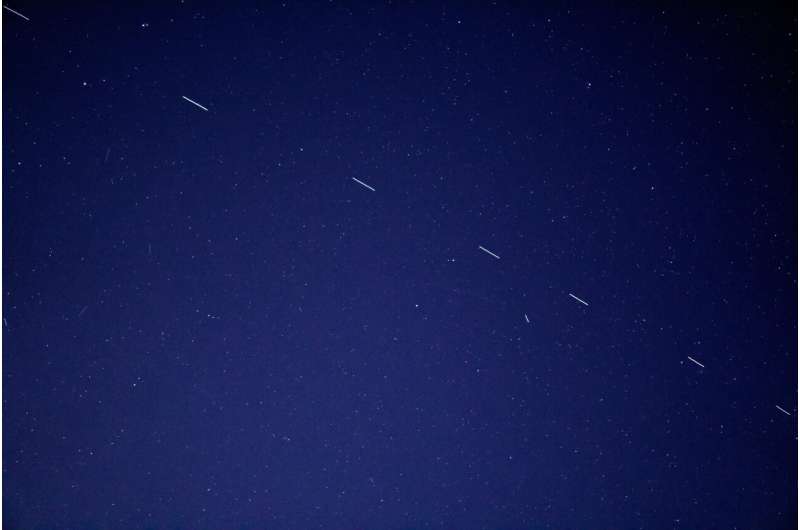Science
Astronomers claim to have solved mystery of the runaway supermassive black hole

|
|
A mysterious trail of stars formed eight thousand million years ago and recently discovered by the Hubble Space Telescope has been a challenge to a number of research groups. Its size is similar to that of the Milky Way, and this very long narrow structure has given rise to several explanations of its origin.
According to a controversial initial hypothesis, this trail of stars could be the result of the passage of a supermassive black hole through a huge cloud of gas. This idea quickly fired the imagination of the astronomical community, because it needs a large set of complex exceptional circumstances. For this reason several scientific teams have continued to explore different and less exotic scenarios that could explain the observations.
In a recent study published in Astronomy & Astrophysics, researchers at the Instituto de Astrofísica de Canarias (IAC) have reached the conclusion that this unusual structure of stars could be interpreted as a galaxy without a bulge seen edge-on. Galaxies of this type, also called thin or flat galaxies, are relatively common.
“The motions, the size, and the quantity of stars fits what has been seen in galaxies within the local universe,” explains Jorge Sanchez Almeida, an IAC researcher who is the first author of the article. “It’s a relief to have found the solution to this mystery; the new proposed scenario is much simpler. In one sense it is also a pity, because the existence of fleeing black holes is expected, and this could have been the first one to be observed.”
To support the hypothesis of the interpretation in terms of a galaxy, the team compared the mysterious structure with a well-known local galaxy without a bulge, IC5249, which has a similar mass of stars, and found surprising agreement. In the words of Mireia Montes, an IAC researcher who is a co-author of the article, “When we analyzed the velocities of this distant structure of stars, we realized that they were very similar to those obtained from the rotation of galaxies, so we decided to compare a much closer galaxy, and found that they are extraordinarily similar.”
“We also looked at the relation between the mass of the assumed galaxy and its maximum velocity of rotation, and discovered that indeed it is a galaxy which behaves like a galaxy,” states Ignacio Trujillo, an IAC researcher who took part in the study. “It is an interesting object, because it is quite a large galaxy at a very large distance from Earth, where the majority of the galaxies are smaller,” he adds.
Upcoming observations will allow the study of this object in greater detail.
More information:
Jorge Sánchez Almeida et al, Supermassive black hole wake or bulgeless edge-on galaxy?, Astronomy & Astrophysics (2023). DOI: 10.1051/0004-6361/202346430
Provided by
Instituto de Astrofísica de Canarias
Citation:
Astronomers claim to have solved mystery of the runaway supermassive black hole (2023, May 9)
retrieved 10 May 2023
from https://phys.org/news/2023-05-astronomers-mystery-runaway-supermassive-black.html
This document is subject to copyright. Apart from any fair dealing for the purpose of private study or research, no
part may be reproduced without the written permission. The content is provided for information purposes only.





Science
Nasa's Hubble marks 34th anniversary with stunning view of Little Dumbbell Nebula – The Times of India


In celebration of its 34th anniversary, Nasa‘s Hubble Space Telescope has once again wowed astronomers and space enthusiasts alike by capturing an extraordinary image of the Little Dumbbell Nebula. This latest image offers a vivid glimpse into the complexities of a planetary nebula, demonstrating Hubble’s enduring capabilities in its extended mission.
The Little Dumbbell Nebula, also known as Messier 76, is one of the faintest objects in the Messier catalog and has intrigued astronomers for its intricate structure and dual-lobed shape. This planetary nebula, located approximately 2,500 light-years away in the constellation Perseus, represents a brief stage in the life cycle of a moderate-sized star like our sun.
Dr. Jennifer Wiseman, a senior scientist at Nasa’s Goddard Space Flight Center, expressed her admiration for the new imagery: “This beautiful nebula is what remains after a star like our own sun has exhausted the bulk of its nuclear fuel and shed its outer layers. The vibrant colors and intricate structures visible in the nebula are a telescope’s way of painting the portrait of the final stages of stellar evolution.”
The Little Dumbbell Nebula, despite its faintness, shines brightly in the detailed images provided by Hubble, allowing scientists to study aspects of the nebula that are rarely visible. The images highlight the dense, glowing gas and complex layers of material expelled from the dying star at the center of the nebula.
According to Dr. Wiseman, “Hubble’s high-resolution capabilities allow us to examine the fine details within the nebula, helping us understand how stars expel their material and the dynamics of this expulsion process. This image is more than just a picture; it’s a deep dive into the life of stars.”
Since its launch on April 24, 1990, Hubble has revolutionized our understanding of the universe, from the dynamics of galaxies to the atmospheres of exoplanets and the distribution of dark matter. Its contributions continue to support and complement data gathered by newer space observatories.
As Hubble continues its journey in space, the scientific community remains enthusiastic about the ongoing contributions it will bring to our understanding of the cosmos. Dr. Wiseman remarked, “Every image from Hubble is a new lesson in our cosmic curriculum.”
These observations not only contribute significantly to our knowledge of the life cycle of stars but also continue to highlight the critical role of Hubble in the exploration and understanding of our universe. As Hubble enters another year in orbit, its legacy of discoveries promises to keep inspiring both the scientific community and the public.
Science
SpaceX launch marks 300th successful booster landing – Phys.org


SpaceX sent up the 30th launch from the Space Coast for the year on the evening of April 23, a mission that also featured the company’s 300th successful booster recovery.
A Falcon 9 rocket carrying 23 of SpaceX’s Starlink internet satellites blasted off at 6:17 p.m. Eastern time from Cape Canaveral Space Force Station’s Space Launch Complex 40.
The first-stage booster set a milestone of the 300th time a Falcon 9 or Falcon Heavy booster made a successful recovery landing, and the 270th time SpaceX has reflown a booster.
This particular booster made its ninth trip to space, a resume that includes one human spaceflight, Crew-6. It made its latest recovery landing downrange on the droneship Just Read the Instructions in the Atlantic Ocean.
The company’s first successful booster recovery came in December 2015, and it has not had a failed booster landing since February 2021.
The current record holder for flights flew 11 days ago making its 20th trip off the launch pad.
SpaceX has been responsible for all but two of the launches this year from either Kennedy Space Center or Cape Canaveral with United Launch Alliance having launched the other two.
SpaceX could knock out more launches before the end of the month, putting the Space Coast on pace to hit more than 90 by the end of the year, but the rate of launches by SpaceX is also set to pick up for the remainder of the year with some turnaround times at the Cape’s SLC-40 coming in less than three days.
That could amp up frequency so the Space Coast could surpass 100 launches before the end of the year, with the majority coming from SpaceX. It hosted 72 launches in 2023.
More launches from ULA are on tap as well, though, including the May 6 launch atop an Atlas V rocket of the Boeing CST-100 Starliner with a pair of NASA astronauts to the International Space Station.
ULA is also preparing for the second launch ever of its new Vulcan Centaur rocket, which recently received its second Blue Origin BE-4 engine and is just waiting on the payload, Sierra Space’s Dream Chaser spacecraft, to make its way to the Space Coast.
Blue Origin has its own rocket it wants to launch this year as well, with New Glenn making its debut as early as September, according to SLD 45’s range manifest.
2024 Orlando Sentinel. Distributed by Tribune Content Agency, LLC.
Citation:
SpaceX launch marks 300th successful booster landing (2024, April 24)
retrieved 24 April 2024
from https://phys.org/news/2024-04-spacex-300th-successful-booster.html
This document is subject to copyright. Apart from any fair dealing for the purpose of private study or research, no
part may be reproduced without the written permission. The content is provided for information purposes only.
Science
Wildlife Wednesday: loons are suffering as water clarity diminishes – Canadian Geographic


The common loon, that icon of northern wilderness, is under threat from climate change due to declining water clarity. Published earlier this month in the journal Ecology, a study conducted by biologists from Chapman University and Rensselaer Polytechnic Institute in the U.S. has demonstrated the first clear evidence of an effect of climate change on this species whose distinct call is so tied to the soundscape of Canada’s lakes and wetlands.
Through the course of their research, the scientists found that July rainfall results in reduced July water clarify in loon territories in Northern Wisconsin. In turn, this makes it difficult for adult loons to find and capture their prey — mainly small fish — underwater, meaning they are unable to meet their chicks’ metabolic needs. Undernourished, the chicks face higher mortality rates. The consistent foraging techniques used by loons across their range means this impact is likely echoed wherever they are found — from Alaska to Canada to Iceland.
The researchers used Landsat imagery to find that there has been a 25-year consistent decline in water clarity, and during this period, body weights of adult loon and chicks alike have also declined. With July being the month of most rapid growth in young loons, the study also pinpointed water clarity in July as being the greatest predictor of loon body weight.
One explanation for why heavier rainfall leads to reduced water clarity is the rain might carry dissolved organic matter into lakes from adjacent streams and shoreline areas. Lawn fertilizers, pet waste and septic system leaks may also be to blame.
The researchers, led by Chapman University professor Walter Piper, hope to use these insights to further conservation efforts for this bird Piper describes as both “so beloved and so poorly understood.”
Return of the king
-



 Politics21 hours ago
Politics21 hours agoOpinion: Fear the politicization of pensions, no matter the politician
-



 Politics20 hours ago
Politics20 hours agoPecker’s Trump Trial Testimony Is a Lesson in Power Politics
-



 Science21 hours ago
Science21 hours agoNASA Celebrates As 1977’s Voyager 1 Phones Home At Last
-
Media14 hours ago
B.C. online harms bill on hold after deal with social media firms
-
Media20 hours ago
B.C. puts online harms bill on hold after agreement with social media companies
-
Business20 hours ago
Oil Firms Doubtful Trans Mountain Pipeline Will Start Full Service by May 1st
-
Media19 hours ago
Trump poised to clinch US$1.3-billion social media company stock award
-



 Investment14 hours ago
Investment14 hours agoMOF: Govt to establish high-level facilitation platform to oversee potential, approved strategic investments





